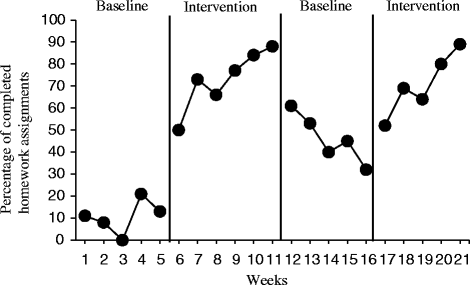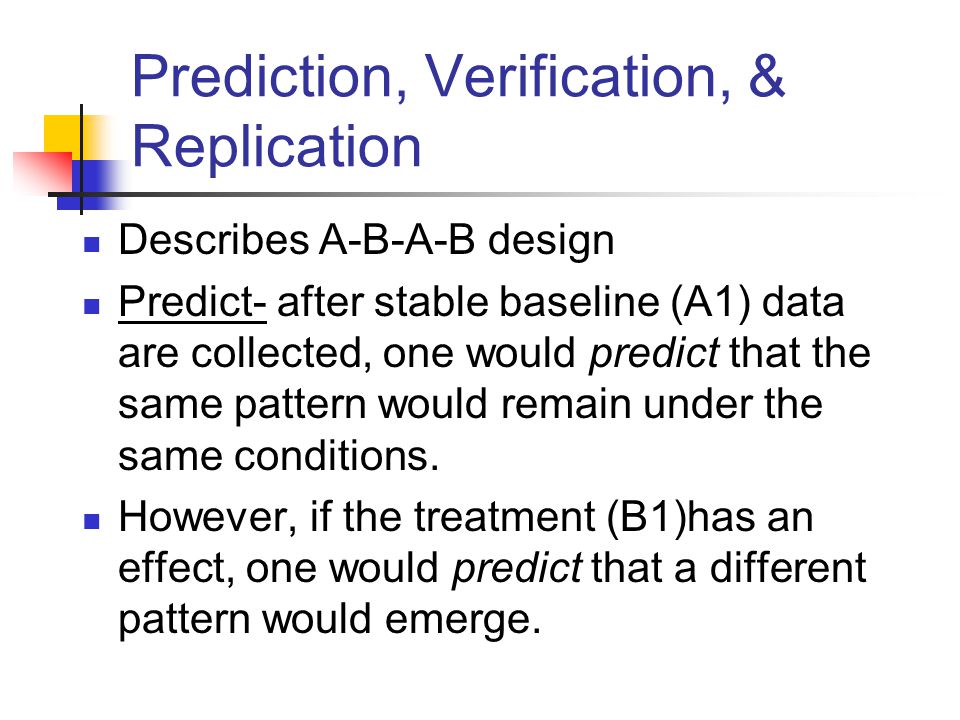Multiple Treatment Reversal Design
Multiple treatment reversal design. Regarding this what is withdrawal design. The major distinction is that the ATD involves the rapid alternation of two or. An experimental design where baseline conditions A and an intervention conditions B are reversed with the goal of strengthening experimental control ie.
An adapted multiple treatment reversal design was used in which all standard vending machines dispensing snack foods andor cold beverages changed the number of slots containing i less healthy items and ii healthier items over seven 4-week periods between September 2017 and March 2018 see Table 1. In a multiple-treatment reversal design A single-subject research design in which phases that introduce different treatments are alternated a baseline phase is followed by separate phases in which different treatments are introduced. -Reversals occur frequently just differently than in reversal design Multi-element vs alternating treatment as described by Kazdin Multi-element varies treatments across stimulus conditions but alternating treatments balances them across all conditions.
Demonstrating that the change in the dependent variable is. These designs are similar to the above reversals in how control is evaluated but differ primarily in that baseline phases are not required. An adapted multiple treatment reversal design was used altering products available in ten vending machines serving snack foods andor cold drinks.
The multiple-baseline design involves replication across participants settings or behaviors in a single participant or groups. Reversal designs are a type of single-case design used to examine the effect of a treatment on the behavior of a single participant. Wine glass size can influence both perceptions of portion size and the amount poured but its impact upon.
In a multiple-treatment reversal design a baseline phase is followed by separate phases in which different treatments are introduced. Alcohol consumption is ranked 5th amongst the 20 leading risk factors for global burden of disease 1. Reversal A-B-A-B Design Multiple Baseline Design MultielementAlternating Treatment Design Changing Criterion Design Reversal A-B-A-B Design Definition.
Other reversal designs ie B-C-B-C involve the comparison of differential yet consecutive treatment interventions across multiple phase shifts. Multielement design Description two or more interventions are implemented in the same phase Fast alternation _____ between baseline and interventions across or within sessions Separate interventions are associated with distinct stimulus conditions Purpose learner performs differently under the two intervention conditions Sometimes multiple-schedule design Kazdin 2011 21816. The researcher mea- sures the behavior of the participant repeatedly during what is referred to as the baseline phase.
Altering the number of options available and the proportion of healthier options - in hospital vending machines. A multiple treatment reversal design Abstract.
For example a researcher might establish a baseline of studying behaviour for a disruptive student A then introduce a treatment involving positive attention from the teacher B and then switch to a treatment involving mild punishment for not studying C.
These designs are similar to the above reversals in how control is evaluated but differ primarily in that baseline phases are not required. A multiple treatment reversal design Abstract. Multiple treatment reversal design any experimental design that uses the experimental methods and logic of the reversal tactic to compare the effects of two or more. The multiple-baseline design involves replication across participants settings or behaviors in a single participant or groups. Other reversal designs ie B-C-B-C involve the comparison of differential yet consecutive treatment interventions across multiple phase shifts. Wine glass size can influence both perceptions of portion size and the amount poured but its impact upon. The major distinction is that the ATD involves the rapid alternation of two or. Demonstrating that the change in the dependent variable is. An experimental design where baseline conditions A and an intervention conditions B are reversed with the goal of strengthening experimental control ie.
The major distinction is that the ATD involves the rapid alternation of two or. An adapted multiple treatment reversal design was used in which all standard vending machines dispensing snack foods andor cold beverages changed the number of slots containing i less healthy items and ii healthier items over seven 4-week periods between September 2017 and March 2018 see Table 1. Demonstrating that the change in the dependent variable is. Alternating treatments design ATD The logic of the ATD is similar to that of multiple-treatment designs and the types of research questions that it can address are also comparable. -Reversals occur frequently just differently than in reversal design Multi-element vs alternating treatment as described by Kazdin Multi-element varies treatments across stimulus conditions but alternating treatments balances them across all conditions. For example a researcher might establish a baseline of studying behaviour for a disruptive student A then introduce a treatment involving positive attention from the teacher B and then switch to a treatment involving mild punishment for not studying C. In a multiple-treatment reversal design a baseline phase is followed by separate phases in which different treatments are introduced.






























Post a Comment for "Multiple Treatment Reversal Design"